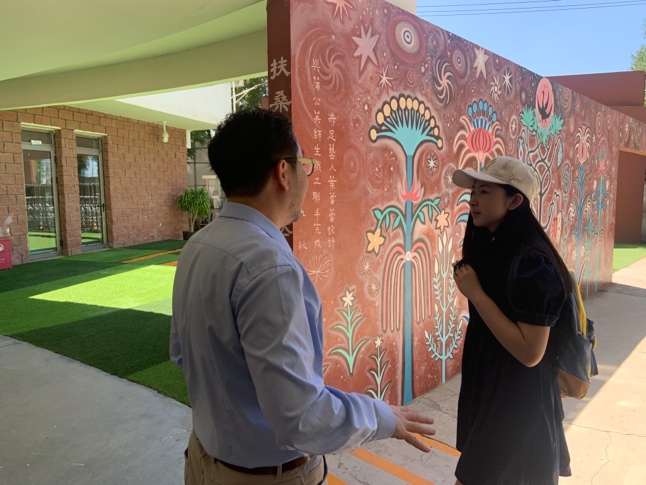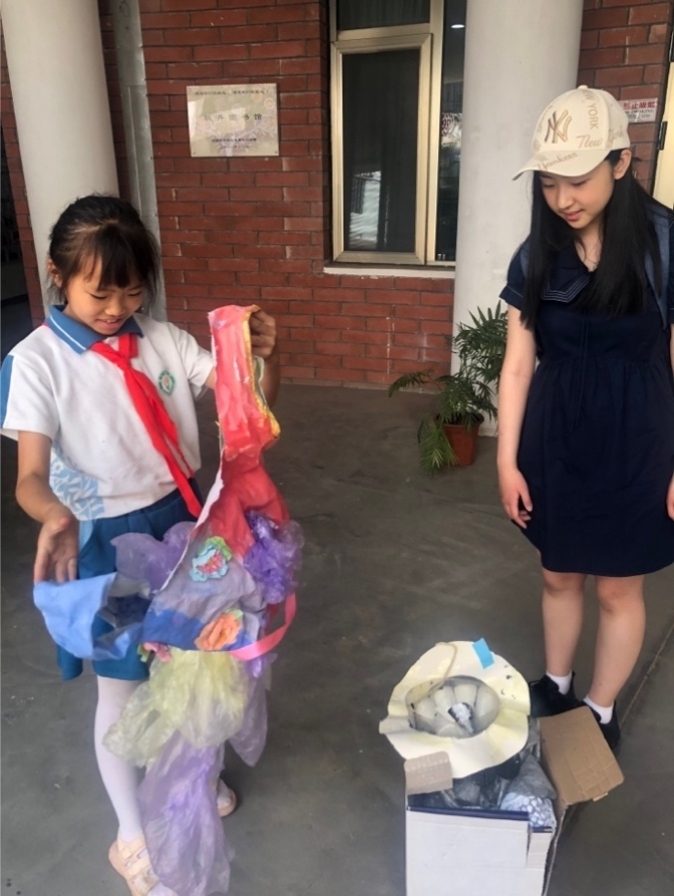

By Emily Chen

Next to the Dandelion Forest, listening to the professor explain the history of the school. (Photo provided to Guangming Online)
The Tree of Life, crowned with snowy branches and ruby-speckled dandelions – this is an emblem of The Dandelion School, the only non-profit primary and middle school in Beijing for students from low-income migrant families. There are approximately 292 million rural migrant workers in China, who generally seek employment in cities away from home. When they relocate to other cities for employment, their children are also uprooted from their learning environment, to which they may have struggled to adapt. The Dandelion School provides them with a stable education, thus contributing to their growth and challenging stereotypes about migrant children. Moreover, it shatters and reconstructs their world on three levels: rebuilding their physical campus, reforming their mindset, and combating the ossification of the social structure. On my first visit, the campus itself shattered my preconceptions. For a charitable school, I pictured shabby buildings and bare cement. Yet the architecture is modern. Staircases spiral above a round plaza, its white tiles glinting like a moving eye in the sun. Plaques of gratitude for sponsors, community photographs, graffiti, and handprints decorate every wall. Down to each brick and tile, the school felt alive.
The students themselves were engaged in reconstructing their physical environment. The Dandelion School’s philosophy is that “one needs not be ashamed of patches, only of holes”. Hence, although it did not possess the best ornaments or facilities, the community worked with whatever materials were available to them to beautify their campus. Under the guidance of the artist Lily Yeh, the redecoration of the walls became an art project. Students went on a quest for discarded bricks and tiles, dragged them from the Tartarean depths of trash piles, broke them down into fragments, and resurrected them as pieces in rainbow murals. Around the flag post and along walkways, they form galleries of geometric patterns, sprouting leaves, and blossoms of dandelions in the Tree of Life. Like their tiles, the children at the school undergo an intellectual revival. On entering, many were years behind in education and had failed their middle school exams. Yet the majority continue on to high school and college, matriculating to various parts of the world. There was something in the patient instruction of volunteers, fellow boarders who sympathized with their situation, or simply the aura of color and artistry on campus that powered the students’ academic self-drive.
In this way, the Dandelion school also reconstructed the children’s mindset. They regained confidence and a sense of self-worth despite the low-income, migrant status of their families. A map outside each classroom displays the hometown of every student, teaching them to share and take pride in their native cultures. As I toured through the campus, the students waved, undisturbed by our presence; a girl on cleaning duty twirled around freely with her broom, as if dancing; a fourth grader stepped up to me with a boxful of hand-crafted costumes, her eyes agleam. Her father was a subway operator, she told me, miming a driver with her hands, and although he could not always be with her, she was proud of him. Far from seeming restricted by pressuring circumstances, she and the others struck me with their frankness and sense of freedom. My guide explained that the students were used to strangers arriving, and because when they came, they always offered some type of comfort or assistance, even the youngest children learned to be not nervous but grateful. They celebrated the stories of those who have made their education possible: from the volunteer teachers that guided them to donors who contributed small funds every week so that they could have baths, and then eggs, and then chicken legs on Fridays.

A student at the Dandelion School and her visual arts project. (Photo provided to Guangming Online)
It is this simplicity and openness of the community that renders the school a fresh page where so much can be reimagined, restructured, and rebuilt. The Dandelion School also eliminates borders between classes by functioning as a medium where the socially privileged and underprivileged can meet as equals in an educational context. Volunteers from global institutions, high schools, and Ivy League colleges such as Harvard come every year to lead academic sessions and interact with the students. They form close emotional bonds. The school is stifling and humid due to the lack of air conditioners, even so, most volunteers choose to return after one summer. Once, a volunteer named Jimmy promised the students that he would do so the following semester. Yet although he passed away that very year, his mother and sister returned to keep his promise. Relationships established at the Dandelion School endure, transcending the boundaries of society and (in Jimmy’s case) even of life.
When arriving on campus, I asked a question: “Why ‘dandelion’? Why not ‘rose’ or any other flower?” According to the headmaster, this is an analogy to the students themselves. A dandelion is a common flower, but one whose seeds are dispersed across the world by a breath of wind. Similarly, the students, though coming from humble backgrounds, are seeds that can fly when propelled by education. They can go anywhere and become anyone that they desire. Hence, the dandelion also plays on the idea of “migrant”; the word itself is redefined to signify fluidity and autonomy rather than a limitation in the children’s lives. In all these aspects, the Dandelion School is a seed of change. The rest of the world would progress if it, too, could break and reconstruct, and be open to learning.
Yinuo (Emily) Chen is a 15-year-old Chinese student at Branksome Hall, Canada. She is a member of the China Film Critics Association and has published a number of reviews. As an actress, she won international awards for her performance in the movie "When a Peking Family Meets an Au-Pair". She has also written, directed, and starred in public welfare short films. In her spare time, Emily enjoys writing, musical theatre, graphic design, and studying various languages.
点击右上角![]() 微信好友
微信好友
 朋友圈
朋友圈

请使用浏览器分享功能进行分享
